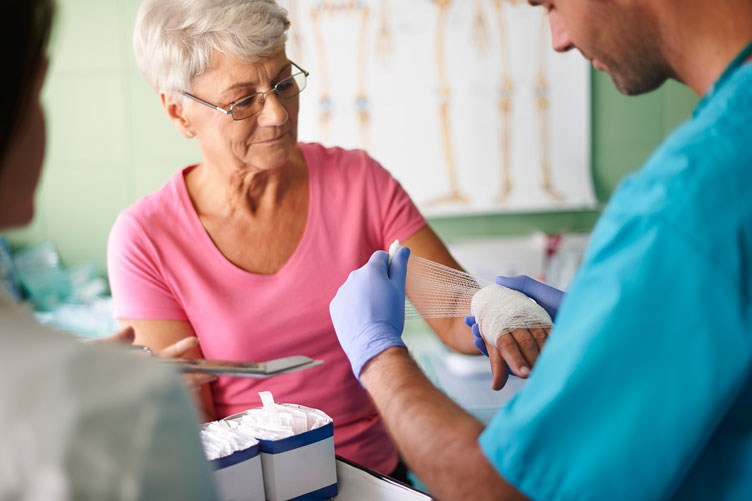Bleeding also known as hemorrhage means blood loss. It can be internal bleeding (blood loss inside the body) or external bleeding (blood loss outside the body). Hemorrhage ranges from minor (bruises) to major (bleeding in the brain).
When blood leaks from blood vessels or organs, bleeding may happen inside the body. Bleeding may occur outside the body when, through a natural opening, blood flows or when blood flows through a skin injury.
Mild bleeding stop on its own. After 15 minutes of pressure, the bleeding ceases or reduces to an oozing or trickle.
Moderate bleeding stops when pressure is applied. But if you release the pressure, it starts again.
In severe bleeding, blood pours from the wound, which doesn’t stop with pressure.
Severe external bleeding– Depending on where the injury is located on the body, even a minor wound might cause considerable external bleeding. It can result in shock. The lack of adequate blood circulation causes shock in the injured person.
Internal bleeding– The most common form of internal bleeding that is visible is a bruise, which occurs when blood from broken blood vessels spills into the nearby skin. Examples are head injury and lung injury.
It’s crucial to keep in mind that even if you can’t see any blood, an injured person could still be bleeding internally. Any type of internal bleeding cannot be controlled or treated with first aid. Quick medical assistance is required.
When bleeding is severe, seek medical attention immediately. Internal bleeding can be life-threatening. Visit Specialty Care Clinics as soon as possible or just dial 469-545-9983.

WHICH FACTORS CONTRIBUTE MOST COMMONLY TO HEMORRHAGE OR BLEEDING?
The most common causes of bleeding include-
Medical conditions- Conditions that can cause bleeding include the following-
- Brain trauma
- Lung cancer
- Leukemia
- Vitamin K deficiency
- Thrombocytopenia
- Acute bronchitis
Medications- Medications that could cause bleeding include-
- Long term antibiotics
- Blood thinner
- Radiation therapy
Traumatic bleeding- Traumatic injuries may vary and include-
- Puncture wounds
- Gunshot wounds
- Bruises
- Cuts
- Abrasions
Long-term alcohol, or drug use
Blood clotting disorders
Internal organ injuries
Hereditary disorders, such as hemophilia
Precautions to take –
- Seek emergency care if the wound is deep. Move the injured individual only if it is necessary to prevent further harm. Don’t touch the wound with bare hands, use disposable gloves, if you have one.
- Don’t attempt to clean the wound; instead, remove any visible debris. Don’t examine the wound or remove big or deeply attached objects.
- The wound should be covered with a clean cloth or sterile gauze. Press firmly with your hands till the bleeding stops. But don’t press on an eye injury or head wound. Raising the wound above the heart is recommended if possible.
- Lay down an injured person on a blanket if possible to stop the body from losing heat and reduce the risk of fainting. Reassure the injured person calmly.
- If the blood flow through the bandage, add more cloth to it.
As you wait for emergency assistance, make an effort to prevent the injured individual from moving. - After helping an injured person wash your hands, even if it looks clean. This prevents infection.
- Do not check the wound again. This may disrupt the wound and cause it to bleed again.
- Use tourniquets as the last option. Steps to follow for applying tourniquets-
- Place the tourniquet in the appropriate location.
- Use bandages if possible to create a tourniquet. Tie a half knot after wrapping them around the limb. To tie another knot with the loose ends, make sure there is adequate space.
- Place a stick between the knots.
- Tighten the bandage by twisting the stick. Secure it with tape or cloth.
- Check it every 10 mins and if the bleeding stops or slows down, remove the tourniquets and use direct pressure.
WHAT IS CONSIDERED A MEDICAL EMERGENCY?
Seek immediate medical attention if a severe injury results in bleeding, bleeding is uncontrollable or it is internal.
Before taking you to the hospital, the paramedics will make an effort to stop the bleeding. Depending on the injury, different types of treatment are required.
WHAT HAPPENS IF BLEEDING IS LEFT UNTREATED?
Minor wounds can be treated with first aid and require no further treatment. Deep wounds may require sutures or surgery.
If the bleeding is caused by a medical condition, it may recur. Without medical attention, any bleeding that persists may become fatal. Even illnesses that result in gradual blood loss over time can add up to serious organ damage and even death.
HOW DOES BLEEDING AFFECT THE BODY?
Depending on where and how severe it is, a hemorrhage can affect how you feel in many different ways. For example, bleeding in the brain causes headaches and bruise mild discomfort.
Dizzy, tired, nauseous, breathless, weak, touching your skin feels cool are all symptoms you may feel during heavy blood loss. If it is left untreated, it may result in chest pain, seizures, shock, coma, confusion, and organ failure.

HOW DO YOU KNOW IF BLEEDING IS SERIOUS?
Seek emergency medical assistance if any of the following symptoms suddenly appear. Possible signs of internal bleeding include these:
- Dizziness
- Low blood pressure
- Numbness
- Headache
- Chest pain
- Passing out
- Breathlessness
HOW MUCH BLEEDING IS SERIOUS?
When blood loss reaches 15-30% of the total volume, you will start experiencing mild effects like increased heart and respiratory rates. Your blood pressure will decrease.
Your body will react traumatically when blood loss approaches 30 to 40% of total blood volume. Your heart rate will increase and your blood pressure will fall even lower. Your breathing will become shallower and faster.
